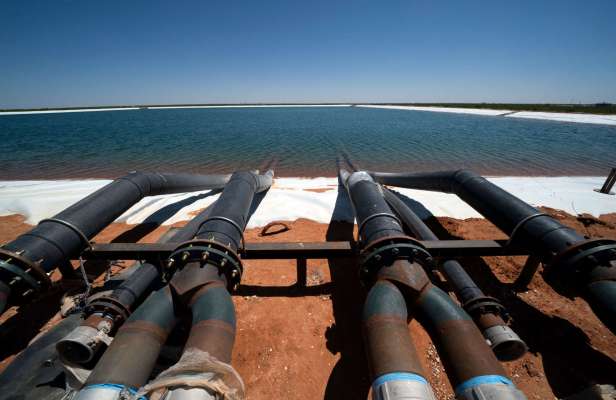EPA Approval of PFAS for Fracking May Spell a New Health Crisis for Communities
By Leanna First-Arai | Truthout | July 30, 2021

Read the full article by Leanna First-Arai (Truthout)
“For over a month, noxious wastewater has been leaching across the ground on Ashley Watt’s family ranch in the Permian Basin in West Texas where she lives and raises cattle. It started in mid-June, when a well Chevron Corps drilled in the 1960s (and plugged with cement in the 1990s before abandoning it) burst open. The well spewed what Watt described on Twitter as “super concentrated brine and benzene” into her water supply, the Pecos River Basin alluvial aquifer.
After a month on site, according to Watt, Chevron plugged the well on July 16, but it failed a pressure test and continued bubbling brine at the surface again just over an hour later. Two calves and four cows have died, as Bloomberg News reported, and the well continues to spray onto the sandy land, where the water table is just over 50 feet below ground. ‘Anything poured on the surface will be in the water table shortly,’ Watt wrote. ‘This is a desert, and without clean water there is no ranch nor home.’
This isn’t Watt’s first tussle with Chevron, nor the first time she’s had to contend with what the industry leaves in its wake. In 2002, after she flushed a toilet at her house, crude oil bubbled up. In 2018, her mother fell ill with adrenocortical carcinoma and passed away mere months later, which Watt noted may have been linked with Chevron’s lack of compliance with well water testing from 2007 to 2013, after a crude oil plume appeared in the groundwater.
The company has said it is committed to re-plugging the leak, according to the Associated Press, but evades responsibility for what Watt fears could be a larger problem: if the same thing happens with dozens of other wells on her land. A representative of Chevron told CBS, “any claims that link subsurface activity to the surface leak at [the well] are premature and unsubstantiated.”
Now, in addition to trying to get Chevron to clean up and remediate her water supply, Watt and others living in oil- and gas-producing regions may have an additional future-facing health threat to consider. In July, Physicians for Social Responsibility (PSR) launched the results of an investigation providing evidence that at least 130 oil and gas companies including Chevron and ExxonMobil have used per- and polyfluoroalkyl substances (PFAS), or chemicals that can break down into PFAS in fracking in at least 1,200 wells in the U.S. since 2012.
PFAS is the class of synthetic chemicals known colloquially as ‘forever chemicals’ on account of their carbon and fluorine bonds, which take thousands of years to break down and have the tendency to build up in the human body and natural environment. Scientists have linked PFAS to congenital disabilities, preeclampsia, thyroid disease, and kidney and testicular cancer.
Given their properties, the chemicals may have been added to a mix of other chemicals, high-pressure water and sand on account of their ability to help reduce friction and thicken fluid to force the mixture deeper underground and release more suspended oil and gas. In general, wells tend to be injected deep into the earth and pass through groundwater, according to the report. In spite of grave concerns at the Environmental Protection Agency (EPA) over the chemicals’ toxicity and longevity, revealed through a Freedom of Information Act request, the EPA did not issue a requirement that follow-up testing be performed, which the report attributes in part to the lax nature of the Toxic Substances Control Act (TSCA), which the Trump administration rolled back even further. ‘The Government Accountability Office has consistently included EPA’s program regulating toxic chemicals on its list of federal government programs at the highest risk of waste, fraud, abuse and mismanagement,’ Dusty Horwitt writes in the report.”…
This content provided by the PFAS Project.
Location:
Topics: